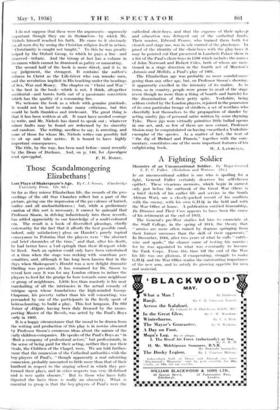Those Scandalmongering Elizabethans !
Lost Plays of Shakespeare's Age. By C. J. Sisson. (Cambridgo cniversity Press. 12s. dd.)
So far as they mirror Elizabethan life, the records of the pro- ceedings of the old Star Chamber reflect but a part of the picture, giving one the impression of the prevalence of hatred, malice and all uncharitableness ; but, while a preliminary caution of .this sort is necessary, it cannot be gainsaid that Professor Simon, in delving industriously into these records, has added. appreciably to our knowledge of a multi-coloured era. The result is a book of diversified pleasings, chiefly noteworthy for the fact that it affords the best possible (and, indeed, only satisfactory) gloss on Hamlet's purely topical conveyance, to Polonius that the players were the abstract and brief chronicles of the time," and that, after his death, he had better have a Lad epitaph than their ill-report while he lived. Such an opinion-could only have been entertained at a time when the stage was -reeking with .scurrilous per- sonalities, and, although it has long been known that in the days when Shakespeare's Ifantlet was a new delight dramatic libelling was prevalent, it has remained for Dr. Sisson to reveal how easy it was for any London citizen to induce the players to feed fat the grudge he bore towards some neighbour or group of neighbours. Little less than masterly is his neat marshalling of all the intricacies in the actual comedy of intrigue upon whose foundations the high-minded George Chapman,, his poverty rather than his will consenting, was persuaded by one of the participants in the lively. sport of heiress-hunting, to .build a play. This lost lampoon, The Old Joiner of Aldgate, having been duly licensed by the unsus- pecting Master-of the Revels, was acted by the Paul's Boys early in 1603.
It is a happy circumstance that the moral to be drawn from the writing and production of this play is in nowise obscured by Professor Sisson's erroneous ideas about the nature of the early children-companies. He speaks of the Paul's Boys as "in ?!feet a company of professional actors," but professionals, in the sense of being paid for their acting, neither they nor their rivals, the Children of the Chapel, were. We are told further- more that the connexion of the Cathedral authorities with the boy-players cif • Paul's, " though apparently a real subsisting connexion, probably amounted-to-little more than that of their landlord in respect to the singing school in which they per- formed their plays, and in other respects was very ill-defined and is now quite obscure." But. to those who have fully digested- the facts there is really no obscurity.. What . is essential to grasp is that the boy-players of Paul's were the cathedral choir-boys, and that the expense of their upkeep and education was defrayed out of the cathedral funds; Their master, Edward Pearce, who trained them both for church and stage use, was in sole control of the playhouse. In proof of the identity of the choir-boys with the play-boys it may be pointed out that preserved in Lambeth Palace there is a list of the Paul's choir-boys in 1598 which includes the mows of John Norwood and Robert Coles, both of whom are men- tioned in a stage direction in the fourth act of Marston's Antonio and Mellida, a Paul's play of 1601.
The Elizabethan age was probably no more scandal-mon- gering than any other age, but, on Professor Sisson's showing, • it apparently excelled in, the intensity of its malice. As in town, so in country, people were prone to avail of the stage (even though no more than a thing of boards and barrels) for the dissemination of their petty spite. Yorkshire, being seldom visited by the London players, rejoiced in the possession of its own particular troupe of strollers, a set of worthies who cheerfully lent themselves to the propagation of slander by acting sundry jigs of personal satire written by some rhyming Tyke. TheSe jigs were virtually primitive little ballad operas in one act, and, so few of them are now extant, Professof Sission may be congratulated on having tmearthed a Yorkshire exemplar of the species. As a matter of fact, the text of " the Jig of Michael and Francis," together with the coin- mentary, constitutes one of the more important featureS of his














































 Previous page
Previous page